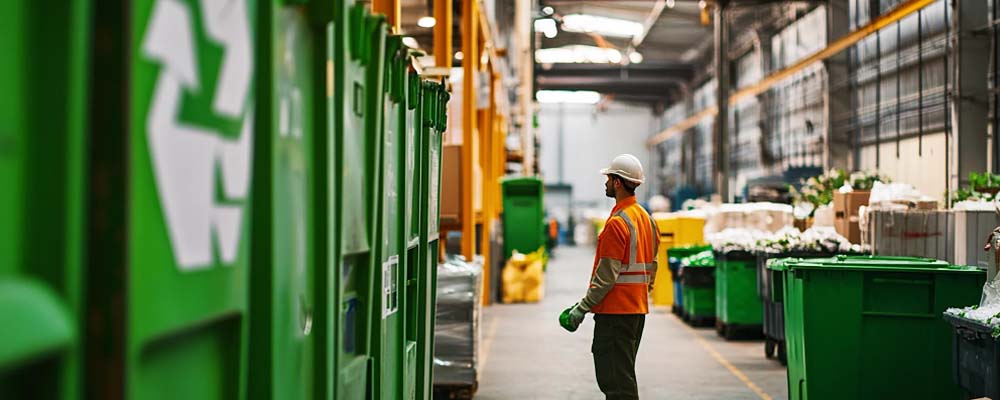
The logistics and freight forwarding industry is a critical element of the global supply chain, enabling the efficient movement of goods across borders and continents. However, this essential role comes with a significant environmental cost, particularly in terms of greenhouse gas emissions. With increasing awareness of climate change and its implications, it has become imperative for the logistics industry to embrace more sustainable practices. As international shipping and transportation continue to grow, freight forwarders must adopt green logistics solutions that minimize their environmental footprint while maintaining efficiency in the supply chain.
This article will explore the various aspects of sustainable transportation, the vital role of waste management in logistics, and the benefits of implementing green logistics solutions for both the environment and businesses involved in freight forwarding.
Sustainable Transportation Options in Logistics
Transportation is one of the largest contributors to emissions within the supply chain, with road, air, and sea transport all playing substantial roles. However, there are more sustainable alternatives and logistics solutions that can help reduce emissions and contribute to a greener future.
1. Rail Transport
Rail transport is one of the most energy-efficient means of transportation, especially for long-distance shipments. Compared to road freight, rail transport emits significantly lower greenhouse gases, making it an ideal choice for companies looking to minimize their carbon footprint. Rail is particularly suited for bulk shipments and long-haul transport, where it can reduce congestion on roads and minimize fuel consumption.
For logistics service providers, integrating rail transport into their offerings can provide a highly sustainable solution. In addition, modern freight trains have adopted technological advancements that improve energy efficiency, further enhancing their role in sustainable logistics.
2. Water Transport
Shipping, particularly ocean freight, is the backbone of international trade and is responsible for the movement of vast quantities of cargo across the globe. Water transport remains a more sustainable option compared to air and road transportation, especially over long distances. Ships are capable of carrying massive volumes of goods, making it a fuel-efficient mode of transportation for bulk and containerized cargo.
In recent years, innovations in shipping have included the development of more fuel-efficient vessels and the use of cleaner fuels, reducing emissions even further. The rise of “slow steaming,” where ships reduce speed to save fuel, also highlights the industry’s commitment to greener logistics solutions. For freight forwarders, incorporating water transport into intermodal logistics strategies can significantly reduce environmental impact.
3. Intermodal Transportation
Intermodal transportation refers to the use of multiple modes of transport (such as rail, road, and sea) to move cargo efficiently and sustainably. This approach allows logistics providers to optimize routes and reduce emissions by selecting the most energy-efficient modes of transport for different legs of the journey. By using a combination of rail and sea transport for the bulk of long-distance shipping, and only relying on road transport for short legs, forwarders can drastically cut down their carbon emissions.
The integration of intermodal logistics not only improves sustainability but also enhances supply chain management by optimizing transportation costs and reducing transit times.
4. Electric and Hybrid Vehicles
With advancements in clean energy technologies, the use of electric and hybrid vehicles is becoming increasingly viable for road transport. These vehicles produce zero or significantly reduced emissions, making them a sustainable alternative for last-mile deliveries and urban freight distribution. As cities worldwide impose stricter emissions regulations, electric vehicles (EVs) will become a necessity for logistics companies aiming to remain competitive.
Hybrid trucks that combine conventional engines with electric propulsion systems are already in use, providing a flexible option for long-haul freight that can switch between electric power in low-emission zones and fuel-powered engines for longer trips. This shift towards electric and hybrid vehicles in logistics not only reduces emissions but also addresses growing concerns about air pollution and sustainability in the industry.
 The Role of Packaging and Waste Management in Logistics
The Role of Packaging and Waste Management in Logistics
Beyond transportation, logistics providers also have a significant role to play in reducing waste and optimizing packaging practices. Waste management is a critical component of green logistics, as packaging and materials often end up as landfill waste, contributing to environmental degradation.
1. Sustainable Packaging
In logistics services, packaging plays an essential role in protecting goods during transportation, but it can also generate substantial waste if not managed responsibly. Sustainable packaging involves the use of materials that are either recyclable or biodegradable. By shifting to eco-friendly materials, logistics companies can reduce their reliance on non-renewable resources and minimize waste generation.
Moreover, sustainable packaging often reduces the overall volume of packaging material used, which in turn reduces the weight of shipments. This results in lower fuel consumption during transportation and contributes to a more sustainable logistics operation.
2. Packaging Optimization
Optimizing packaging design is another key strategy in reducing waste and enhancing the efficiency of the logistics supply chain. By minimizing the amount of packaging material used, logistics providers can reduce transportation costs and improve load efficiency. Properly designed packaging can maximize the use of container space, reducing the number of trips needed and, consequently, emissions from transportation.
Freight forwarders can work closely with manufacturers and distributors to implement packaging optimization techniques, ensuring that products are shipped with minimal excess packaging while still being adequately protected.
3. Effective Waste Management Practices
Recycling, composting, and waste reduction programs are essential elements of green logistics solutions. Logistics companies can implement waste management systems that focus on diverting materials from landfills, thereby reducing the environmental impact of their operations. By establishing processes for recycling packaging materials, logistics providers can recover valuable resources and reduce the carbon emissions associated with waste disposal.
Implementing a circular economy approach, where waste products are reused or repurposed, can further enhance sustainability efforts in logistics and freight forwarding. Additionally, waste reduction initiatives can lead to cost savings by lowering the need for raw materials and reducing disposal costs.
 Benefits of Implementing Green Logistics Practices
Benefits of Implementing Green Logistics Practices
The adoption of sustainable practices in the logistics and freight forwarding industry offers numerous advantages, both for businesses and the environment. The shift towards green logistics solutions is not only driven by corporate social responsibility but also by the tangible benefits it brings to operational efficiency, cost savings, and brand reputation.
1. Reduced Carbon Emissions
By choosing sustainable transportation options and optimizing packaging and waste management, logistics companies can drastically reduce their carbon emissions. This reduction is essential in combating climate change and aligning with international environmental standards. Freight forwarders that embrace green logistics can play a pivotal role in the global effort to reduce emissions and create a more sustainable future.
2. Enhanced Brand Reputation
Consumers, investors, and partners are increasingly placing importance on sustainability when selecting business partners. By adopting green logistics practices, freight forwarders can enhance their brand reputation and attract environmentally conscious clients. Companies that demonstrate a commitment to reducing their environmental impact can also gain a competitive edge in the marketplace, as sustainability becomes a key differentiator.
3. Cost Savings
Sustainable logistics practices often lead to significant cost savings. By reducing fuel consumption through the use of energy-efficient transportation methods and optimizing packaging, companies can lower their operational expenses. Additionally, waste reduction initiatives can result in lower waste disposal costs and reduced reliance on raw materials. In the long term, these savings can contribute to improved profitability and more sustainable business growth.
4. Improved Risk Management
Climate change poses a range of risks to businesses, including disruptions to supply chains, extreme weather events, and rising insurance premiums. By implementing green logistics practices, companies can mitigate these risks and enhance their resilience. Sustainable logistics solutions also enable businesses to stay ahead of regulatory changes, as governments increasingly impose stricter environmental standards on industries such as transportation and logistics.
 Conclusion
Conclusion
Sustainability is no longer a choice for the logistics and freight forwarding industry; it is a necessity. As the world grapples with the urgent threat of climate change, logistics service providers must take the lead in adopting sustainable transportation options and waste management practices. By integrating green logistics solutions, freight forwarders can reduce their environmental impact, improve efficiency, and enhance their brand reputation. Sustainable logistics is not only an ethical responsibility but also a strategic business decision that can lead to long-term success in an increasingly competitive global marketplace.




 The Role of Packaging and Waste Management in Logistics
The Role of Packaging and Waste Management in Logistics Benefits of Implementing Green Logistics Practices
Benefits of Implementing Green Logistics Practices Conclusion
Conclusion



